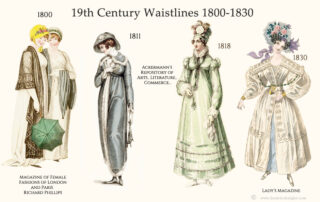Regency Waistlines Part One
Empire waists and white muslin dresses are synonymous with the Regency era. The look defined early 19th century English fashion for over 20 years. This post is the first of three about changing waistlines during the era. Part Two covers the formal Regency period from 1811-1820 and Part Three the decade from 1820-1830, when the Prince Regent reigned as King George IV. Regency Waistlines Part One As the 19th century dawned, English fashion was more or less in lockstep with Paris. Decades of so-called anglomanie in France had been sparked by Voltaire's [...]
Regency Waistlines Part Two 1811-1820
When George became Prince Regent in 1811, Great Britain had been at war with Napoleon for seven years. Decoupled from Paris trends, English fashions had gone rogue. Regency Waistlines Part Two - 1811-1820 Having started the 19th century with Empire styles inspired by classical Greece and Rome, by 1811 English fashions were increasingly influenced by the Romantic movement and by public sentiment about the war with Napoleon. Waistlines had taken their first dive in the hot summer of 1808 and demi-trains had now vanished in streetwear. Inch-by-inch, waistlines had lengthened since 1809 and bodices became more [...]
Regency Waistlines Part Three 1820-1830
Empire waists epitomized Regency England, but change was underway when the Prince Regent finally took the throne as King George IV in 1820. The broader Regency era would last until his death in 1830, and the ten years of his rule would witness some of the most dramatic shifts in the history of women's fashion. Regency Waistlines Part Three 1820-1830 The 1820s was a decade of transition that would sweep away the Empire waist and neo-classical styles women had been wearing since the late 1790s. It did not happen overnight. 1820 was a [...]
Other Interesting Posts
Outsiders Within – Romani in the Regency
By the time 'Gypsies' appeared on the pages of Jane Austen, Sir Walter Scott and Maria Edgeworth, Romani people had been in England for centuries. Sidebar: Believing the copper-skinned migrants to hail from Egypt, the Europeans had coined the term "Gypsies" for these migrants. Some consider [...]




